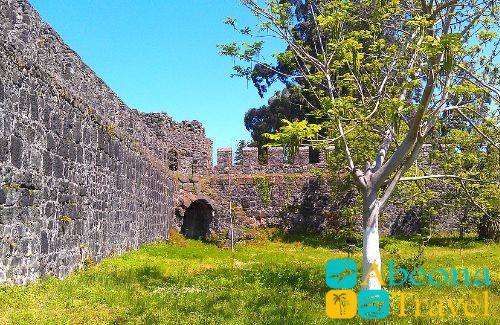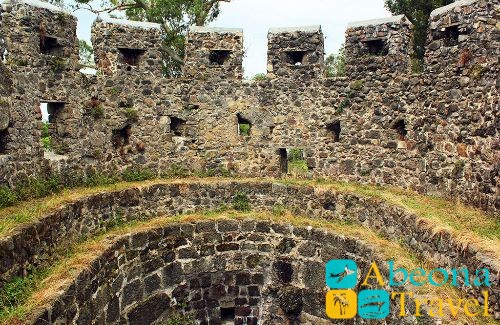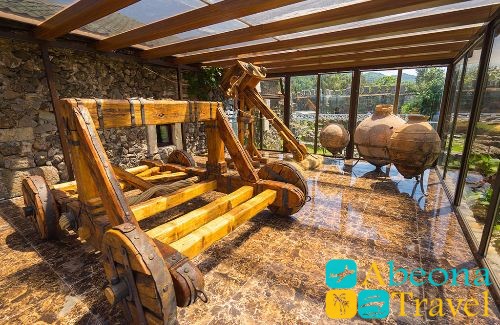 To the south of Batumi, at a distance of 12 km, on the left bank of the Chorokhi River, near the border with Turkey, is the Gonio-Apsaros Fortress, which is a 4.5-hectare. It is a real paradise for lovers of historical and cultural antiquity. The architectural masonry of the fortress is highlighted. The total length of its walls is 900 meters, the height of the walls is 5 meters. And the height of the towers is 7 meters. To date, the Gonio fortress has 18 towers, but originally there were 22. The four main towers were located in the corners of the fortress wall.
To the south of Batumi, at a distance of 12 km, on the left bank of the Chorokhi River, near the border with Turkey, is the Gonio-Apsaros Fortress, which is a 4.5-hectare. It is a real paradise for lovers of historical and cultural antiquity. The architectural masonry of the fortress is highlighted. The total length of its walls is 900 meters, the height of the walls is 5 meters. And the height of the towers is 7 meters. To date, the Gonio fortress has 18 towers, but originally there were 22. The four main towers were located in the corners of the fortress wall.
Previously, the fortress had 4 entrances, but only the western gate was preserved. The Gonio fortress has a unique strategic importance. It protected the entrances to the gorges of the Chorokhi and Ajaristskali rivers that linked the inland areas of southwestern Georgia to the Black Sea coast. Gonio fortress turned into a strong Black Sea citadel of the Roman Empire. Later – Byzantium due its location. In this region the bronze culture of Kolkhida was born. Here the first Georgian state associations emerged.
According to Roman-Byzantine written testimonies, about the same time Apsaros appeared the place on which the fortress was built, as a settlement. His name is closely related to the Myth of the Argonauts. According to legend, King Ayet was buried by the body of his son Apsirt, dismembered by Jason. The interested traveler here learns that today the most ancient archaeological layer, which dates back to the 15th-17th centuries BC, was excavated here. Beyond the southern wall of the fortress were found graves dating from the 5th century AD.
The revival of urban life is observed here from the Hellenistic era. According to many historians of the time, the Gonio fortress was a strategic, political, economic and cultural center of the eastern border of Rome. In the Ist-IIIrd of our centuries there was a theater and a racetrack here. In Apsaros one of the apostles of Christ, Matata, is buried. Archaeological excavations of the Gonio-Apsaros fortress have been conducted since the 60s of the 20th century. In 1974, a treasure, dated by II-III of our century was accidentally discovered on the adjoining territory of the fortress. Since 1994, there is continuous scientific work here. Gonio fortress was declared a museum-preserve.
The Gonio fortress had a unique strategic significance. It reliably protected all entrances to the gorge of the Acharistskali and Chorokhi rivers, which were connected to the Black Sea coast by the inner regions of southwestern Georgia. The fortress turned into a strong supporting Black Sea citadel first of the Roman Empire, and much later – Byzantium. Local and foreign archaeologists have done a grandiose work here: excavated the oldest unique archaeological layer, dating back to the XV-XVII BC. Behind the strong southern wall of the fortress are found amazing burials, dating from V century AD.
The real revival of the turbulent urban life has been observed here since the Hellenistic era. According to many historians of the time, the Gonio fortress was considered as the most strategic, economic, political and cultural center of the entire eastern border of Rome. Here in the I-III centuries AD successfully ran a racecourse and a theater. Constant archaeological excavations are being carried out in this place since the 60s of the 20th century. In 1974, near the fortress, a treasure, dated to the 2nd-3rd centuries AD, was discovered by chance. Gonio Fortress was declared a museum-reserve in 1994 and since then a continuous and fruitful scientific work has been carried out here.
Gonio Fortress was declared a museum-reserve in 1994 and since then a continuous and fruitful scientific work has been carried out here.
Looking at the dilapidated buildings, and now you can freely understand that once there were real Roman baths. In the VI century the Byzantines came to Apsar. And in the 17th century, as is known from history, Ajara was conquered by the Ottoman Empire, the Turkish troops stood for a long time in the fortress, and the stunning waters were rebuilt into oriental baths. Yet significant signs of Roman civilization still survived throughout the fortress.
For example, the original sewer pipes, laid out by the Romans in the II century, amazing stone tees for the necessary distribution of pipes, the powerful foundations of the barracks and the wonderful building of the praetorian. From the last, in an absolutely surprising manner, there were even huge stone pedestals. Do not be surprised, this is the grave of the apostle Matthew. Tradition says that the apostle came here after the death of his teacher. And it was here, in the fortress, long preached the teaching of Christ, here he died. Right opposite the cross is the well-preserved building of the mosque of the Turkish garrison.
Stones seem to come alive and whisper about what they had see for so many centuries. Be sure to look into this fortress – there you forget about modern vanity.
Want to order excursion to “Gonio-Apsaros Fortress”. Press here
Gonio-Apsaros Fortress
Do you have any questions or would you like to visit sight?
Please fill in the following form and we will contact you.
[fc id=’7′ align=’left’][/fc]



